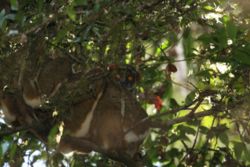Woolly lemur: Difference between revisions
imported>Kim van der Linde (added taxobox) |
imported>Lee R. Berger (→Status) |
||
| Line 57: | Line 57: | ||
*''''A. cleesei'''' | *''''A. cleesei'''' | ||
The fur above the forehead is blackish and forms a dark chevron pattern. The snout is black and hairless. Head body fur is brown-grey. The tail can be grey-brown to grey<ref name= "Mittermeier"/>. | The fur above the forehead is blackish and forms a dark chevron pattern. The snout is black and hairless. Head body fur is brown-grey. The tail can be grey-brown to grey<ref name= "Mittermeier"/>. | ||
===Behaviour=== | ===Behaviour=== | ||
Unknown<ref name= "Mittermeier"/>. | Unknown<ref name= "Mittermeier"/>. | ||
Revision as of 12:05, 13 September 2007
| Woolly lemurs | ||||||||||||
|---|---|---|---|---|---|---|---|---|---|---|---|---|
 A pair of Eastern Woolly lemurs, (Avahi laniger) nesting during the day. Note the distinctive white stripe along the thigh which is one of the most distinguishing features of the woolly lemurs.Template:Photo
| ||||||||||||
| Scientific classification | ||||||||||||
| ||||||||||||
| Type species | ||||||||||||
| Lemur laniger Gmelin, 1788 | ||||||||||||
| [[taxon|Species]] | ||||||||||||
The Woolly lemurs, Genus Avahi, are medium-sized quadrupedal lemurs. In the wild, they are only found on the island of Madagascar.
Description
The woolly lemur group of primates contain the only nocturnal members of the family Indridae (which includes the largest living lemur – the Indri). There are presently four recognized species in the woolly lemur group. All of the presently recognized species of woolly lemurs are very similar in appearance and due to their being nocturnal, it can be very difficult to distinguish the differing species in the wild. It can also be difficult to distinguish them from certain species of Lepilemur. There are recorded body sizes for both A. laniger and A. occidentalis (head body lengths of approximately 25 – 30 cm and a tail length of around 31-37 cm)[1][2][3]. Weight ranges for these two species are approximately 900 and 1,300 grams for A. laniger and 700 to 900 grams for A. occidentalis[3]There are no reported body size data published for A. unicolor. A single male A. cleesei weighed 830g[3]. The woolly lemurs common name comes from the curly, woolly appearance of the dense fur [3]. Their hindlimbs are proportionally longer than the trunk and forelimbs and they have long tails that are typically longer than the body[3].
Characteristics of each species
- 'A. laniger'
Darker than A. occidentalis, this species has a dense coat that is grey-brown to reddish, paler towards the tail – which is a rusty red colo[3]r.
Behaviour
It is reported that there have been no long term studies of A. laniger, but it is thought they may live in monogamous pairs [3]. Groups of up to five have been reported and home range is thought to be around 1-2ha. Where studies have been conducted, all Avahi eat flowers and fruits, but its diet consists mainly of leaves[3].
Geographic range
This species ranges across almost the whole of Madagascar’s eastern rainforest[3].
Status
A. laniger is considered Least Concern by the IUCN.
- 'A. occidentalis'
The dense coat of the back is light to medium sometimes flecked with brown or olive, paler towards the tail – which is also grey[3][4].
Behaviour
It is reported that there have been no long term studies of A. laniger, but it is thought they may live in monogamous pairs [3][4]. Groups of up to five have been reported and home range is thought to be around 1-2ha[4]. Young leaves and buds are reported to be the preferred food[3][4].
Geographic range
This species ranges is reported to range north and east of the Betsiboka River as far as the Bay of Narinda[3][4].
Status
'A. occidentalis' is considered Endangered by the IUCN.
- 'A. unicolor'
Back color is sandy-brownish grey. The tail can be slightly darker or even reddish brown although the base of the tail may be cream colored[3][4]. The coloration of the face gives the impression of a facial mask[4].
Behaviour
Unknown[3].
Geographic range
This species is thought to be restricted to the tropical lowland forests of the Sambirano egion of northwestern Madagascar[3][4].
Status
A. unicolor is considered “data deficient” by the IUCN.
- 'A. cleesei'
The fur above the forehead is blackish and forms a dark chevron pattern. The snout is black and hairless. Head body fur is brown-grey. The tail can be grey-brown to grey[3].
Behaviour
Unknown[3].
Geographic range
This new species is only known from the Tsingy de Bemaraha region of western Madagascar [3].
Status
Un-assessed.
References
- ↑ J. Fleagle (1998). Primate Adaptation and Evolution. Academic Press: New York.
- ↑ F. Szalay and E. Delson (2001). Evolutionary History of the Primates. Academic Press, New York.
- ↑ 3.00 3.01 3.02 3.03 3.04 3.05 3.06 3.07 3.08 3.09 3.10 3.11 3.12 3.13 3.14 3.15 3.16 3.17 3.18 Mittermeier et al. (2006). Lemurs of Madagascar. Conservation International.
- ↑ 4.0 4.1 4.2 4.3 4.4 4.5 4.6 4.7 J. Fleagle (1998). Distribution and geographic variation in the western woolly lemur (Avahi occidentalis) with description of a new species (A. unicolor). Int. J. Primat., 371-376.